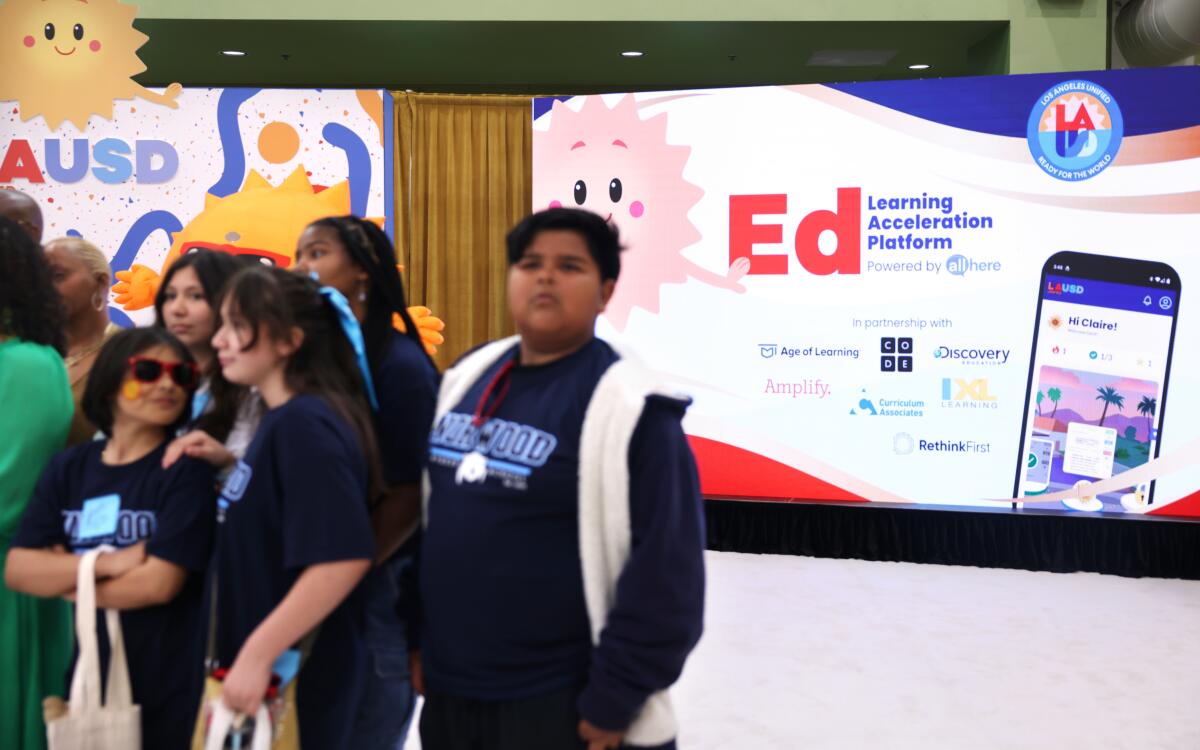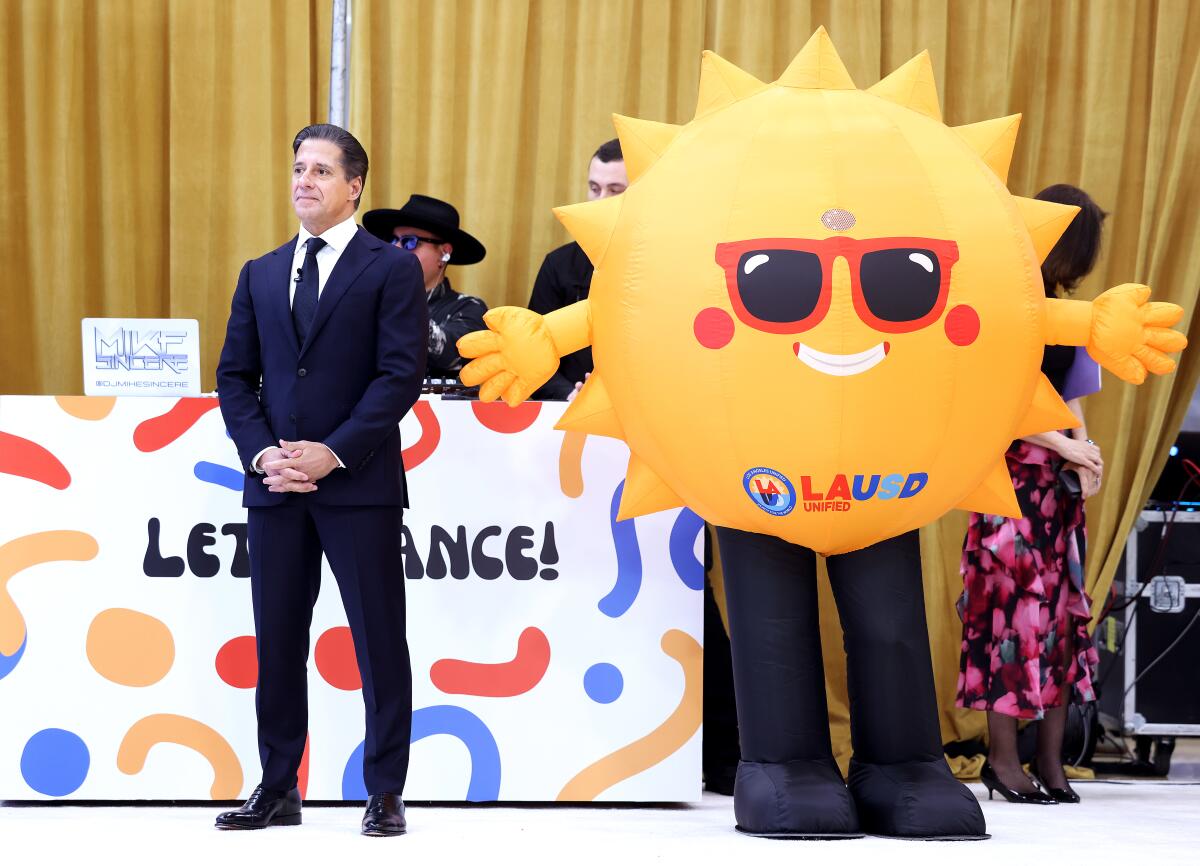The Los Angeles school district on Wednesday unveiled a much-awaited AI tool, dubbed “Ed,” to serve as a student advisor, programmed to tell its young users and their parents about grades, tests results and attendance — while giving out assignments, suggesting readings and even helping students cope with nonacademic matters.
Although some sounded cautionary notes about this foray into artificial intelligence, the arrival of Ed heralded efforts by L.A. schools Supt. Alberto M. Carvalho to establish the nation’s second-largest school system as a hub for innovation.
“This is a technology that becomes a personal assistant to students,” Carvalho said at a demonstration at Roybal Learning Center, west of downtown. “It demystifies the navigation of the day … crunches the data in a way that it brings what students need.”
As educators try to better engage students and families to improve learning and attendance, other school systems have pioneered similar platforms with chatbots. But Ed takes such efforts to the highest level yet, said Joanna Smith-Griffin, chief executive of Boston-based AllHere, which has worked with districts across the country and won a $6-million contract over five years to guide the L.A. effort.

The LAUSD on Friday launched Ed, an AI tool designed to guide students and their parents in both academic and some nonacademic matters.
(Christina House / Los Angeles Times)
At its core, Ed is designed to give students immediate answers about where they stand, what they need to do to make progress or, more immediately, find out when their bus will arrive. It stands as an example of AI that could help students learn, a contrast from the reality that some students have used AI to cheat or other malfeasance, several experts said.
Ben Chida, senior education advisor to Gov. Gavin Newsom, sees a prime example of innovation.
“We can either wait for 10 years and then have it happen to us and have tech companies decide the logic of how AI applies to education — and then have to untangle that like we did with social media — or we could take hold, take control of our fate and futures, and say: ‘Look, how do we harness this technology in our way?’”
Students try it out
At a table set up with computers, 12th-grader Guadalupe Gaona asked the chatbot some questions.
“What are my grades?”
The program quickly responded with her grades in biology, government, dance, economics and modern lit. Her grades are strong and Ed added: “Keep up the good work!”
She tried other questions suggested by a reporter:
What can I do to improve my math?
“You can improve your math by completing activities on the Ed dashboard. If you need more help, you can log in to [a link] for on-demand help. If you still need more support, please contact your school.”
The answers were generic, not especially personalized, but did provide concrete — if sometimes obvious — suggestions. On-demand tutoring is a recent feature of L.A. Unified, part of pandemic recovery efforts, that is unrelated to the rollout of Ed. This tutoring allows students to access homework help online on request. The innovation with Ed is its inclusion in a new, more comprehensive, one-stop platform.
Who can I talk to about my college applications? the student typed in.
“To get help with your college applications, you can send an email to helpmeapply@lausd.net. Keep going, you’re doing great.”
What school meetings can my parents attend?
Ed identified school site council and school board meetings, but did not provide the promised links.
My bike was stolen. What should I do?
“I understand your bike was stolen. For this situation, you should contact the Los Angeles School Police Department. They have a Bike Patrol Team that might be able to help.”
A question about helping a friend with mental health issues elicited a long list of possible contacts.
For now the district has put limits on the reach of the AI software — it has to stay within the district universe of information. A student, for example, would not be likely to get a reference to a recent development in the war in Ukraine for a research paper, Carvalho said. But that door could be opened in the near future, he added, once district officials confirm that such an expansion would be safe to allow and lead to accurate results.
Mixed reaction from parents
The initial reaction among parents and staff on the popular Facebook group Parents Supporting Teachers was muted and cautious. Most don’t yet have access to the technology.
“How do I know what information this AI Ed will be collecting about my child?” said parent Sharyn Obsatz. “Who will have access to that data? How will the district prevent it from being hacked? Also, as a community college professor and strong union advocate, does this mean the superintendent believes AI Ed can guide our kids better than a human teacher or tutor? Is this the first step to a dystopian future where it’s one teacher per 100 students sitting all day in a massive classroom all being taught/directed by AI?”
Kevin Baker-Cross, a teacher for students with disabilities, said, “AI seems to be another step away from relational learning, and another step towards the depersonalized, one-size-fits-all approach rooted in an unhealthy adoration of data for the sake of data. Spending money on this AI model is just more proof that the district values its relationship with data more than they value the relationship between students and teachers.”
Carvalho said the guidance of teachers, counselors and other staff would remain irreplaceable. Moreover, he added, student data is secure, remaining within the district system, unavailable to participating vendors.
But Alex Molnar, a director of the National Education Policy Center at Colorado University Boulder is not reassured.
“The construction and operation of AI algorithms is largely outside of public view and without any public accountability. Nevertheless, school people are being pushed, both by marketers and government entities, to be seen to be in the forefront of this alleged digital revolution,” he said in a Thursday online policy discussion.
“So-called AI uses algorithms and massive amounts of computing power to produce results based on countless calculations of probabilities,” Molnar added. “These calculations do not produce truth or even, necessarily, accuracy. They produce probabilistic output.”
Carvalho countered such concerns in part by saying that Ed’s accuracy rate was currently 93%, compared to 86% for the popular and public ChatGPT bot.
In its news conference, the district brought forward two parents, the Cunninghams from South L.A., who tried out Ed.
“What I like about it is the immediate response versus me trying to get an answer from the teacher — and I may not get an answer back into the next day,” said Andrea Cunningham.
For now, independent charter schools, which enroll about 110,000 Los Angeles-area students and have their own separate technology and learning systems, will not be part of Ed.
To harness the information and other learning platforms to work with Ed, L.A. Unified had to persuade its many education vendors to open the doors to their platforms — so that students and parents don’t have separate paths, logins and passwords to reach different parts of the system.

Los Angeles Unified Supt. Alberto Carvalho, left, waits with an LAUSD mascot during the official launch of Ed, a new district-developed, AI-assisted learning tool.
(Christina House / Los Angeles Times)
Many vendors have business models that do just the opposite: create a closed ecosystem so that the client would have difficulty integrating with competing products.
Among safeguards built into the effort, the chatbot is unavailable to students younger than 13, and filters flag obscene or insulting language for further review.
Will students love it?
About 1,000 students have been testing the program since late January. At their suggestion, the district added athletic team schedules and cafeteria menus. Other practical information includes how soon the school bus will be arriving.
Animator Kevin O’Donnell worked on the voice, look and personality of Ed, who is represented as a sun with sunglasses.
For older students, “it is about that utility, but with the younger kids, we have to have a character that they love,” O’Donnell said. “And if they do love it, then as they grow, they’ll gravitate back to it.” Ed tells young students that he loves them and that they’re superstars. “I’ve always found that if your character really loves the kids, the kids — the younger kids — tend to love the character.”
As the students get older, the voice and the relationship changes to that of a teacher or older mentor, added O’Donnell.
The project could prove a positive leading indicator for a school district better known for struggling to catch up, and notorious for costly technological misfires.
A vaunted new payroll system created problems for years. A new student information system resulted in classroom and administrative disarray for weeks. An iPads-for-all effort was visionary but derailed by high costs, poor planning and mismanagement. Early in Carvalho’s tenure, a massive computer hack put critical district records at risk, but was contained in time to prevent a catastrophic failure.
Early reviews on Wednesday were positive, including from Nery Paiz, the head of the administrators union, whose school principals would bear the brunt of complaints about the system if it doesn’t work or creates new administrative hassles.
Alan Arkatov, a senior advisor to President Michael Crow at Arizona State University, said the effort could be a game changer in the wake of the pandemic’s academic setbacks.
“There was epic learning loss, and the social emotional damage to parents, teachers and, most importantly, students was again, epic,” Arkatov said. “This is an inflection point that could fundamentally alter the equation. This is a fundamental tool, which allows students to engage, to find their voice.”
Ed is part of an effort to bring about full academic recovery from the pandemic within two years. Intrinsic to the new app is the creation of an individual learning plan for each student. But this element was less clear on Wednesday.
Carvalho had introduced the idea of an “Individual Acceleration Plan” as early as December of 2022, modeled on the Individualized Educational Program, or IEP, that aims to provide a unique, appropriate education and support plan for every student who has a disability.
Advocates for such students have long criticized L.A. Unified for not properly managing its existing system of IEPs, but that isn’t stopping Carvalho from making the general idea universal.
Officials said the chatbot technology, which can communicate in 100 languages, is currently available at the 100 schools the district has designated as its most “fragile,” reaching about 54,000 students out of about 420,000 across the school system.
The app “shows how we really want to prepare our students for the future,” said Karen Ramirez, a senior who is the student representative on the board of education. This sort of technology is “something that they’re going to be working with throughout their entirety of their lives.”

